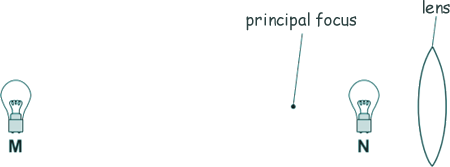GCSE level optics questions
Q20.
(a) Some people have an eye defect called long sight.
(i) State one cause of long sight.
The eyeball is too short or the lens is too weak/thin or the cornea is not curved enough, so the light is focussed behind the retina. 
[1 mark]
(ii) Long sight can be corrected by surgery.
During surgery, the surgeon may need to cut and heat very delicate parts of the eye.
Name the piece of equipment which provides the energy source used to do this.
A laser 
[1 mark]
(b) A light bulb is placed between a convex lens and the principle focus of this lens, at position N shown in the diagram. The light bulb is then moved to position M, a large distance from the lens.

Describe how the nature of the image formed changes as the light bulb is moved from position N to position M.
The image would decrease in size 
The image would change from virtual to real 
The image would change from non-inverted to inverted 
[3 marks]
(c) An object, O, is very near to a convex lens, as shown below. Complete the diagram below to show how rays of light from the object form an image.

[3 marks]
(d) The object distance is the distance from an object to the lens. The image distance is the distance from the lens to the image.
The graph below shows how the image distance changes with the object distance, for two identically shaped convex lenses, A and B.

Each lens is made from a different type of glass.
(i) When the object distance is 4 cm, the image distance for lens A is longer than for lens B. State why this is.
Because the glass in lens A has a greater refractive index or is more powerful or has a shorter focal length 
[1 mark]
(ii) When the object is moved between lens B and the principal focus, the image size changes. The table below shows the magnification produced by lens B for different object distances.
Object distance in cm |
Magnification |
| 0.0 |
1 |
| 5.0 |
2 |
6.7 |
3 |
7.5 |
4 |
8.0 |
5 |
Using information from the graph and the table, describe the relationship between the image distance and the magnification produced by lens B.
As the magnification increases by 1, the image distance increases by 10 cm. 

[2 marks]
(iii) A third convex lens, lens C, is made from the same type of glass as lens B, but has a shorter focal length than lens B.
Lens B is shown in the diagram below.
Complete the diagram to show how lens C differs from lens B.

[1 mark]
(Total 12 marks)










